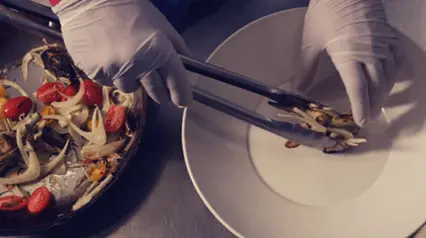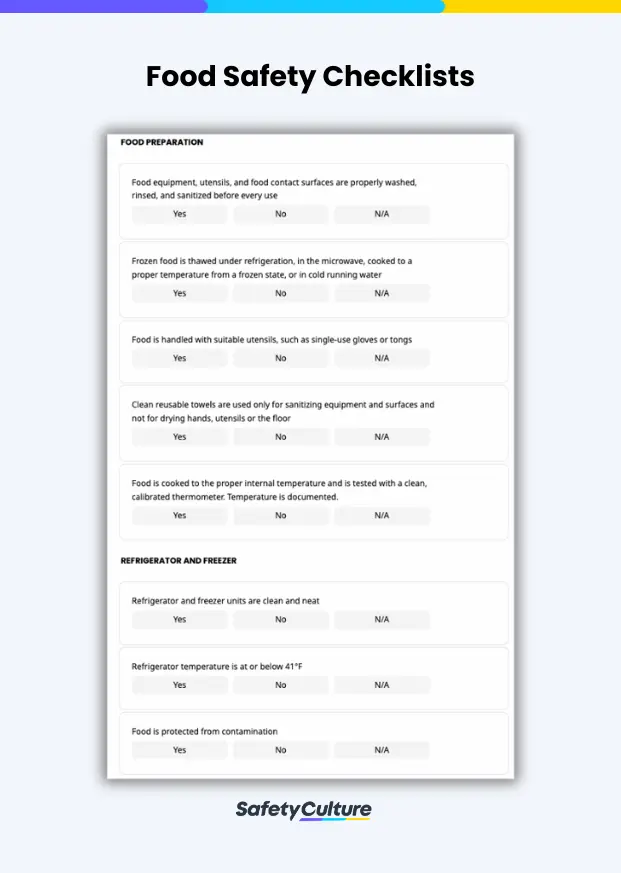What is a Food Safety Checklist?
A food safety checklist is used to evaluate compliance of a food establishment with food safety and good hygiene practices. It can help ensure that activities involving food are done according to set standards. Following food safety practices reduces the likelihood of foodborne illnesses and helps businesses prevent legal and regulatory problems.
The Importance of Using a Food Safety Checklist
According to the World Health Organization, there are almost a million cases of deaths every year that can be attributed to food and water contamination. Although policies and regulations were implemented among food businesses and supplies, incidents involving foodborne diseases and food poisoning are still rampant and remain a global health issue. Conducting regular and thorough safety inspections can help prevent more serious health problems.
A food safety checklist is a simple yet powerful tool that helps food safety and quality personnel to ensure that food quality standards are being met and complied with. Doing so will also be beneficial to identify food safety threats and risks, and set needed actions to mitigate them. Scheduling food safety inspections is also important to promote and improve the safety culture. Risks associated with poor food safety are caused by the following factors:
- Improper food handling and preparation practices – this could happen when food is stored inappropriately, stale and low-quality food are purchased, a large amount of food is prepared and cooked even if the preparation area is not sufficient, raw food is stored together with the cooked ones, and food is cooked using the wrong methods.
- Poor personal hygiene of food handlers – this involves not restricting food handlers who have illnesses and did not go any medical checks. Also when food handlers have poor personal hygiene and do not adhere to wearing the proper clothing during the food preparation.
- Unsanitized kitchen and equipment facilities – this entails using equipment such as dirty chopping boards, rusty knives, unwashed containers, and the like that are in regular contact with the entire food-making process.
The Five Keys to Safer Food
Food safety can be culture. WHO recommended a food safety manual for trainers that can help promote safety in the simplest ways. This manual is divided into two sections: background material and the 5 keys to safer food. Trainers, safety managers, and other competent individuals can use this manual as a guide when evaluating food safety practices in their organization. With SafetyCulture this manual can be digitally repurposed and divided into smaller checklists, especially when the trainer wants to ensure that his audience understands the lessons or when an inspector or safety manager gathers information when assessing how food safety practices are being applied. Here are the five keys to safer food:
#1 Keep Clean
Cleanliness before and during handling food is critically important as harmful microorganisms are usually found in animals, soil, water, and even in people. With the slightest exposure to these microorganisms through hands, utensils, chopping boards, and other preparation equipment, there are also higher tendencies of acquiring foodborne illnesses. Here are some of the core information for maintaining cleanliness during food preparation:
- Ensure to wash hands before handling food and more often during food preparation
- Don’t forget to wash your hands after going to the toilet.
- Always wash and disinfect all surfaces, equipment, and tools used in food handling and preparation.
- Ensure the kitchen area and food are free from pests, insects, and other animals.
#2 Separate Raw and Cooked
Same as mentioned above, dangerous microorganisms can also be found in raw meat, poultry, seafood, and their juices. It is important to separate them from the cooked ones to also prevent them from getting foodborne diseases. Here are some of the core information for maintaining separating raw and cooked food:
- Separate the raw meat, poultry, and seafood from other foods.
- Use different and separate equipment and utensils such as knives and cutting boards for handling raw foods.
- Store food in clean containers to prevent possible contact between raw and cooked foods.
#3 Cook Thoroughly
All dangerous microorganisms can be eliminated if food is cooked properly. According to studies, food must be cooked at a temperature of 70 degrees Celsius for it to be safe for consumption. Foods like minced meats rolled roasts, large joints of meat and whole poultry require special handling and attention. Here are some of the core information for thoroughly cooking food:
- Cook food thoroughly, especially meat, poultry, eggs, and seafood.
- Bring foods like soups and stews to boiling to make sure they have reached 70 degrees Celsius. For meat and poultry, make sure that their juices are clear, not pink. Ideally use a thermometer.
- Reheat cooked food thoroughly.
#4 Keep Food at Safe Temperatures
According to research, food that is stored at room temperature can easily and quickly multiply. Temperatures should be held below 5 degrees Celsius or above 60 degrees Celsius to slow down or stop these dangerous microorganisms from growing. Using sensors can also be vital equipment to notify and send critical alerts when temperatures are not maintained properly. Here are some of the core information for keeping food at safe temperatures:
- Do not leave cooked food at room temperature for more than 2 hours.
- Refrigerate promptly all cooked and perishable foods (preferably below 5 degrees Celsius
- Keep cooked food piping hot (more than 60 degrees Celsius) before serving.
- Do not store food too long even in the refrigerator.
- Do not thaw frozen food at room temperature.
#5 Use Safe Water and Raw Materials
Even water and ice are also subject to the contamination of deadly microorganisms and chemicals. These raw materials should also be washed, purified, and contained in a safe and clean container before use. Here are some of the core information for using water and raw materials:
- Use safe water or treat it to make it safe.
- Select fresh and wholesome foods.
- Choose foods processed for safety, such as pasteurized milk.
- Wash fruits and vegetables, especially if eaten raw.
- Do not use food beyond its expiry date.
What is Kitchen Sanitation?
Kitchen sanitation is an additional step to intensify the cleaning processes. It uses kitchen cleaning chemicals to remove the bacteria that can cause health problems. It is usually performed on commonly touched surfaces to reduce the risk of spreading the microorganisms that might cause COVID-19 or any foodborne illnesses. Kitchen sanitation helps maintain a safe and healthy kitchen environment.
Importance of Kitchen Sanitation
Regular kitchen sanitation is an important part of kitchen operations. It helps improve the health and safety protocols of the organization including food preparation and handling processes. It also helps:
- prevent bacteria to grow on unsanitary surfaces and contaminate the food;
- avert the spread of the coronavirus;
- pass health department requirements; and
- avoid businesses from lawsuits or shut down due to non-compliance with the hygiene policies.
What is a Kitchen Sanitation Checklist?
A kitchen sanitation checklist is a tool used by kitchen staff to ensure all sanitation processes are performed according to the set forth guidelines of the Centers for Disease Control and Prevention (CDC). It helps assess the quality of cleaning and disinfection processes of the kitchen area to protect the health of employees and customers.
How Do You Practice Sanitation in the Kitchen to Maintain Food Safety?
The commercial kitchen is one of the most important areas in the hospitality industry. It should be well maintained, cleaned, and sanitized to meet the requirements of the Department of Health. In addition to kitchen staff healthy personal hygiene, keeping a clean environment within the kitchen area promotes food safety, customer satisfaction, and boosts employee ethics.
Kitchen sanitation should be conducted daily after each shift to ensure the kitchens’ readiness for the next user. Below are some guidelines that could help maintain kitchen cleanliness.
Preparation
Kitchen sanitation requires appropriate disinfection chemicals to ensure food safety. Here are some guidelines to prepare before sanitizing the kitchen.
- All kitchen staff should be trained on the appropriate use of cleaning and disinfection chemicals.
- An employee who is exhibiting symptoms of illnesses should be sent home.
- Wear appropriate Personal Protective Equipment (PPE) when handling cleaning chemicals.
- Ensure there is adequate ventilation around the kitchen area.
- Follow the manufacturer’s instructions listed on the chemicals to be used.
- Avoid mixing different chemicals unless written in the manufacturer guidelines.
Kitchen Safety and Sanitation
It is important to clean and sanitize common kitchen areas regularly to reduce the risk of spreading viruses or bacteria buildup that can cause food cross-contamination or health diseases. Here are some tips you can follow:
- Disinfect high touched surfaces including preparation tables, kitchen sink, refrigerator shelves, light switches, and faucet handles.
- Wash, rinse, and sanitize all food contact surfaces, equipment, and utensils before each use.
- Clean the floor immediately when there is spillage to prevent trips and falls. It is advisable to disinfect and sanitize it at the end of every shift to prevent bacteria buildup and infestation.
- Apply Hazard Analysis Critical Control Point (HACCP) principles in food receiving, preparation, cooking, and storing to mitigate food safety risks and hazards.
- Defrost the refrigerator once a week and wipe it with a clean cloth. Toss out everything and check for expiry dates.
After Kitchen Sanitation
After conducting the kitchen sanitation it is important to do the following:
- Dispose of the kitchen waste every after shift.
- All used chemicals should be labeled accordingly before keeping in storage.
- PPE should be removed carefully and dispose of properly to avoid bacteria contamination.
- Wash hands with soap and water for at least 20 seconds.



